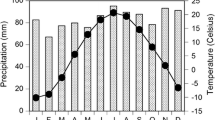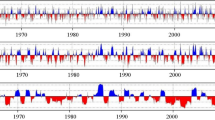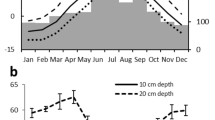Abstract
Key message
Climate responses of radial growth of major hardwood species growing in a cool temperate forest in Japan were clarified by dendrochronological analysis combining the phenology observation of radial growth.
Abstract
To better understand which climate factors limit the radial growth of major hardwood species growing in a cool temperate forest in Japan, we clarified the phenology of radial growth and developed ring width residual chronologies for Betula ermanii, Fagus crenata and Quercus crispula at Takayama, an LTER research site located in central Japan. We inspected stem tissue for division of cambial cells in the early stage of wood formation and examined the cumulative radial growth by the wounding method. The onset of cambial cell division in Q. crispula was observed to be about 2 weeks earlier than in the other species. Wood formation in the final part of the tree ring occurred approximately 1 month earlier in B. ermanii than in the other species. The correlation analysis was performed between chronologies and moving averages of 31-day climate data with a 1-day lag. The periods which revealed significant correlations with climate factors were categorized into the previous growing season, previous autumn, just before the current growing season and current growing season according to their characteristic responses and the phenology of wood formation and leaves. The negative correlations between ring width of all the species and mean and minimum temperatures of previous year’s autumn, when the growth ending of ring width and leaf coloring occurred, suggested that temperature may have affected the respiration rate and/or prolonged the start of leaf fall, resulting in variations of radial growth through the consumption of photosynthetic products. On the other hand, different responses to climate were observed among species during the other phenological periods.








Similar content being viewed by others
References
Andrew GB (2008) A dendrochronology program library in R (dplR). Dendrochronologia 26:115–124. https://doi.org/10.1016/j.dendro.2008.01.002
Arvai M, Morgos A, Kern Z (2018) Growth-climate relations and the enhancement of drought signals in pedunculate oak (Quercus robur L.) tree-ring chronology in Eastern Hungary. Iforest 11:267–274. https://doi.org/10.3832/ifor2348-011
Beck W, Sanders TG, Pofahl U (2013) CLIMTREG: detecting temporal changes in climate–growth reactions—a computer program using intra-annual daily and yearly moving time intervals of variable width. Dendrochronologia 31:232–241. https://doi.org/10.1016/j.dendro.2013.02.003
Begum S, Nakaba S, Oribe Y, Kubo T, Funada R (2007) Induction of cambial reactivation by localized heating in a deciduous hardwood hybrid poplar (Populus sieboldii × P. grandidentata). Ann Bot 100:439–447. https://doi.org/10.1093/aob/mcm130
Begum S, Nakaba S, Bayramzadeh V, Oribe Y, Kubo T, Funada R (2008) Temperature responses of cambial reactivation and xylem differentiation in hybrid poplar (Populus sieboldii × P. grandidentata) under natural conditions. Tree Physiol 28:1813–1819. https://doi.org/10.1093/treephys/28.12.1813
Begum S, Kudo K, Rahman MH, Nakaba S, Yamagishi Y, Nabeshima E, Nugroho WD, Oribe Y, Kitin P, Jin HO, Funada R (2018) Climate change and the regulation of wood formation in trees by temperature. Trees 32:3–15. https://doi.org/10.1007/s00468-017-1587-6
Bergant K, Kajfež-Bogataj L (2005) N-PLS regression as empirical downscaling tool in climate change studies. Theor Appl Climatol 81:11–23. https://doi.org/10.1007/s00704-004-0083-2
Briffa K, Jones PD (1990) Basic chronology statistics and assessment. In: Cook ER, Kairiukstis LA (eds) Methods of dendrochronology. Kluwer Academic Publishers, Dordrecht, pp 137–152
Cook ER (1985) A time series analysis approach to tree ring standardization. Ph.D. dissertation, University of Arizona, Tucson
Cook ER, Peters K (1981) The smoothing spline: a new approach to standardizing forest interior tree-ring width series for dendroclimatic studies. Tree Ring Bull 41:45–54
Čufar K, Prislan P, De Luis M, Gričar J (2008) Tree-ring variation, wood formation and phenology of beech (Fagus sylvatica) from a representative site in Slovenia, SE Central Europe. Trees 22:749–758. https://doi.org/10.1007/s00468-008-0235-6
Čufar K, De Luis M, Prislan P, Gričar J, Črepinšek Z, Merela M, Kajfež-Bogataj L (2015) Do variations in leaf phenology affect radial growth variations in Fagus sylvatica? Int J Biometeorol 59:1127–1132. https://doi.org/10.1007/s00484-014-0896-3
D’Arrigo RD, Yamaguchi DK, Wiles GC, Jacoby GC, Osawa A, Lawrence DM (1997) A kashiwa oak (Quercus dentata) tree-ring width chronology from northern coastal Hokkaido, Japan. Can J For Res 27:613–617. https://doi.org/10.1139/x96-220
Deck C, Wiles G, Frederick S, Matsovsky V et al (2017) Climate response of larch and birch forests across an elevational transect and hemisphere-wide comparisons, Kamchatka Peninsula, Russian Far East. Forests 8:315–326. https://doi.org/10.3390/f8090315
Fonti P, Solomonoff N, García-González I (2007) Earlywood vessels of Castanea sativa record temperature before their formation. New Phytol 173:562–570. https://doi.org/10.1111/j.1469-8137.2006.01945.x
Fritts HC (1976) Tree rings and climate. Academic Press, London
Fujimoto S (2007) Analysis of prediction methods for budburst days based on the phenological observation in 29 broad-leaved tree species for 10 years. J Jpn For Soc 89:253–261. https://doi.org/10.4005/jjfs.89.253
García-Suárez AM, Butler CJ, Baillie MGL (2009) Climate signal in tree-ring chronologies in a temperate climate: a multi-species approach. Dendrochronologia 27:183–198. https://doi.org/10.1016/j.dendro.2009.05.003
González-González BD, García-González I, Vázquez-Ruiz RA (2013) Comparative cambial dynamics and phenology of Quercus robur L. and Q. pyrenaica Willd. In an Atlantic forest of the northwestern Iberian Peninsula. Trees 27:1571–1585. https://doi.org/10.1007/s00468-013-0905-x
Guada G, Vázquez-Ruiz RA, García-González I (2019) Response patterns of xylem and leaf phenology to temperature at the southwestern distribution boundary of Quercus robur: a multi-spatial study. Agric For Meteorol 269:46–56. https://doi.org/10.1016/j.agrformet.2019.02.001
Holmes RL (1983) Computer-assisted quality control in tree-ring dating and measurement. Tree Ring Bull 43:69–78
Holmes RL (1994) Dendrochronology program library version 1994. Laboratory of Tree-Ring Research, University of Arizona, Tucson https://www.ltrr.arizona.edu/software.html. Accessed 24 Oct 2019
Horikawa Y (1972) Fagus crenata Blume. In: Atlas of the Japanese flora, an introduction to plant sociology of East Asia. Gakken, Tokyo, 37p
Hoshino Y (1998) Phytosociological studies of Quercus mongolica var. grosseserrata forest in Japan. Bull Fac Agric Tokyo Univ Agric Technol 32:1–99
Hoshino Y, Yonenobu H, Yasue K, Nobori Y, Mitsutani T (2008) On the radial-growth variations of Japanese beech (Fagus crenata) on the northernmost part of Honshu Island, Japan. J Wood Sci 54:183–188. https://doi.org/10.1007/s10086-007-0935-3
IPCC (2014) AR5 synthesis report: climate change 2014. https://www.ipcc.ch/report/ar5/wg2/. Accessed 1 June 2019
Jacoby G, Solomina O, Frank D, Eremenko N, D’Arrigo R (2004) Kunashir (Kuriles) oak 400——year reconstruction of temperature and relation to the Pacific Decadal Oscillation. Palaeogeogr Palaeocl 209:303–311. https://doi.org/10.1016/j.palaeo.2004.02.015
Jansons Ā, Matisons R, Šēnhofa S, Katrevičs J, Jansons J (2016) High-frequency variation of tree-ring width of some native and alien tree species in Latvia during the period 1965–2009. Dendrochronologia 40:151–158. https://doi.org/10.1016/j.dendro.2016.10.003
Japan Forestry Agency (2012) http://www.rinya.maff.go.jp/. Accessed 1 June 2019
Kagawa A, Sugimoto A, Maximov TC (2006) Seasonal course of translocation, storage and remobilization of 13C pulse-labeled photoassimilate in naturally growing Larix gmelinii saplings. New Phytol 171:793–804. https://doi.org/10.1111/j.1469-8137.2006.01780.x
Kira T (1949) Ringyo Kaisetsu series, 17. Nippon Ringyo Gijutsu Kyokai, Tokyo
Kirdyanov A, Hughes M, Vaganov E, Schweingruber F, Silkin P (2003) The importance of early summer temperature and date of snow melt for tree growth in the Siberian Subarctic. Trees 17:61–69. https://doi.org/10.1007/s00468-002-0209-z
Kitin P, Funada R (2016) Earlywood vessels in ring-porous trees become functional for water transport after bud burst and before the maturation of the current-year leaves. IAWA J 37:315–331. https://doi.org/10.1163/22941932-20160136
Kolář T, Giagli K, Trnka M, Bednářová E, Vavrčík H, Rybníček M (2016) Response of the leaf phenology and tree-ring width of European beech to climate variability. Silva Fenn 50:1520. https://doi.org/10.14214/sf.1520
Kudo K, Nabeshima E, Begum S, Yamagishi Y et al (2014) The effects of localized heating and disbudding on cambial reactivation and formation of earlywood vessels in seedlings of the deciduous ring-porous hardwood, Quercus serrata. Ann Bot 113:1021–1027. https://doi.org/10.1093/aob/mcu026
Kudo K, Yasue K, Hosoo Y, Funada R (2015) Relationship between formation of earlywood vessels and leaf phenology in two ring-porous hardwoods, Quercus serrata and Robinia pseudoacacia, in early spring. J Wood Sci 61:455–464. https://doi.org/10.1007/s10086-015-1487-6
Kujansuu J, Yasue K, Koike T, Abaimov AP et al (2007a) Climatic responses of tree-ring widths of Larix gmelinii on contrasting north-facing and south-facing slopes in central Siberia. J Wood Sci 53:87–93. https://doi.org/10.1007/s10086-006-0837-9
Kujansuu J, Yasue K, Koike T, Abaimov AP et al (2007b) Responses of ring widths and maximum densities of Larix gmelinii to climate on contrasting north-and south-facing slopes in central Siberia. Ecol Res 22:582–592. https://doi.org/10.1007/s11284-006-0062-4
Kuroda K (1986) Wound effects on cytodifferentiation in the secondary xylem of woody plants. Wood Res 72:67–118
Kuroda K, Kiyono Y (1997) Seasonal rhythms of xylem growth measured by the wounding method and with a band-dendrometer: an instance of Chamaecyparis obtusa. IAWA J 18:291–299. https://doi.org/10.1163/22941932-90001493
Maruyama Y (1996) Water content characteristics of major tree species produced in northern areas. Hoppo Ringyo 48:245–248
Miyawaki A (1985) Vegetation of Japan 6 Chubu. Shibundo, Tokyo (in Japanese)
Mosteller F, Tukey JW (1977) Data analysis and regression: a second course in statistics. Addison-Wesley series in Behavioral science, quantitative methods. Addison-Wesley, Reading
Muraoka H, Koizumi H (2009) Satellite Ecology (SATECO)—linking ecology, remote sensing and micrometeorology, from plot to regional scale, for the study of ecosystem structure and function. J Plant Res 122:3–20. https://doi.org/10.1007/s10265-008-0188-2
Muraoka H, Saigusa N, Nasahara KN, Noda H et al (2010) Effects of seasonal and interannual variations in leaf photosynthesis and canopy leaf area index on gross primary production of a cool-temperate deciduous broadleaf forest in Takayama, Japan. J Plant Res 123:563–576. https://doi.org/10.1007/s10265-009-0270-4
Nagai S, Saitoh TM, Kurumado K, Tamagawa I et al (2013) Detection of bio-meteorological year-to-year variation by using digital canopy surface images of a deciduous broad-leaved forest. Sola 9:106–110
Nagai S, Akitsu T, Saitoh TM, Busey RC et al (2018) 8 million phenological and sky images from 29 ecosystems from the Arctic to the tropics: the Phenological Eyes Network. Ecol Res 33:1091–1092. https://doi.org/10.1007/s11284-018-1633-x
Nechita C, Chiriloaei F (2018) Interpreting the effect of regional climate fluctuations on Quercus robur L. trees under a temperate continental climate (southern Romania). Dendrobiology 79:77–89. https://doi.org/10.12657/denbio.079.007
Noda HM, Muraoka H, Nasahara KN, Saigusa N, Murayama S, Koizumi H (2015) Phenology of leaf morphological, photosynthetic, and nitrogen use characteristics of canopy trees in a cool-temperate deciduous broadleaf forest at Takayama, central Japan. Ecol Res 30:247–266. https://doi.org/10.1007/s11284-014-1222-6
Noh NJ, Kuribayashi M, Saitoh TM, Muraoka H (2017) Different responses of soil, heterotrophic and autotrophic respirations to a 4-year soil warming experiment in a cool-temperate deciduous broadleaved forest in central Japan. Agric For Meteorol 247:560–570. https://doi.org/10.1016/j.agrformet.2017.09.002
Numata M, Miyawaki A, Itow D (1972) Natural and semi-natural vegetation in Japan. Blumea 20:435–496
Ohtsuka T, Saigusa N, Koizumi H (2009) On linking multiyear biometric measurements of tree growth with eddy covariance-based net ecosystem production. Glob Change Biol 15:1015–1024. https://doi.org/10.1111/j.1365-2486.2008.01800.x
Oladi R, Pourtahmasi K, Eckstein D, Bräuning A (2011) Seasonal dynamics of wood formation in Oriental beech (Fagus orientalis Lipsky) along an altitudinal gradient in the Hyrcanian forest, Iran. Trees 25:425–433. https://doi.org/10.1007/s00468-010-0517-7
Peng X, Du J, Yang B, Xiao S, Li G (2019) Elevation-influenced variation in canopy and stem phenology of Qinghai spruce, central Qilian Mountains, northeastern Tibetan Plateau. Trees 33:707–717. https://doi.org/10.1007/s00468-019-01810-z
Pérez-de-Lis G, Olano JM, Rozas V, Rossi S, Vázquez-Ruiz RA, García-González I (2017) Environmental conditions and vascular cambium regulate carbon allocation to xylem growth in deciduous oaks. Func Ecol 31:592–603. https://doi.org/10.1111/1365-2435.12789
R Development Core Team (2017) R: a language and environment for statistical computing. Version 3.3.3, R Foundation for Statistical Computing, Vienna, Austria. https://www.r-project.org/. Accessed 28 July 2017
Roy J, Mooney HA, Saugier B (eds) (2001) Terrestrial global productivity. Academic, San Diego
Saigusa N, Yamamoto S, Hirata R, Ohtani Y et al (2008) Temporal and spatial variations in the seasonal patterns of CO2 flux in boreal, temperate, and tropical forests in East Asia. Agric For Meteorol 148:700–713. https://doi.org/10.1016/j.agrformet.2007.12.006
Saitoh TM, Nagai S, Saigusa N, Kobayashi H, Suzuki R, Nasahara KN, Muraoka H (2012) Assessing the use of camera-based indices for characterizing canopy phenology in relation to gross primary production in a deciduous broad-leaved and an evergreen coniferous forest in Japan. Ecol Inform 11:45–54. https://doi.org/10.1016/j.ecoinf.2012.05.001
Schmitt U, Jalkanen R, Eckstein D (2004) Cambium dynamics of Pinus sylvestris and Betula spp. in the northern boreal forest in Finland. Silva Fenn 38:167–178. https://doi.org/10.14214/sf.426
Schweingruber FH (1988) Tree rings: basics and applications of dendrochronology. Kluwer Acad, Norwell, Mass
Schweingruberm FH (1996) Tree rings and environment. Dendroecology. Birmensdorf, Swiss Federal Institute for Forest, Snow and Landscape Research, Haupt, Berne
Seo JW, Eckstein D, Schmitt U (2007) The pinning method: from pinning to data preparation. Dendrochronologia 25:79–86. https://doi.org/10.1016/j.dendro.2007.04.001
Shen Y, Wakui S, Takehara Y, Hoshino Y, Utsumi Y, Kamata N, Nobori Y, Ichie T, Muraoka H, Saitoh T, Hirano Y, Yasue K (2018) Effects of climate on the radial growth of Japanese beech (Fagus crenata) at various sites in Japan. Mokuzai Gakkaishi 64:171–186. https://doi.org/10.2488/jwrs.64.171
Stokes MA, Smiley TL (1996) An introduction to tree-ring dating. University of Arizona Press, Tucson
Suzuki M, Yoda K, Suzuki H (1996) Phenological comparison of the onset of vessel formation between ring-porous and diffuse-porous deciduous trees in a Japanese temperate forest. IAWA J 17:431–444
Takahashi K, Okuhara I (2012) Comparison of climatic effects on radial growth of evergreen broad-leaved trees at their northern distribution limit and co-dominating deciduous broad-leaved trees and evergreen conifers. Ecol Res 27:125–132. https://doi.org/10.1007/s11284-011-0879-3
Takahashi K, Azuma H, Yasue K (2003) Effects of climate on the radial growth of tree species in the upper and lower distribution limits of an altitudinal ecotone on Mount Norikura, central Japan. Ecol Res 18:549–558. https://doi.org/10.1046/j.1440-1703.2003.00577.x
Takahashi K, Tokumitsu Y, Yasue K (2005) Climatic factors affecting the tree-ring width of Betula ermanii at the timberline on Mount Norikura, central Japan. Ecol Res 20:445–451. https://doi.org/10.1007/s11284-005-0060-y
Takahashi S, Okada N, Nobuchi T (2013) Relationship between the timing of vessel formation and leaf phenology in ten ring-porous and diffuse-porous deciduous tree species. Ecol Res 28:615–624. https://doi.org/10.1007/s11284-013-1053-x
Ueno K, Isono J, Imaizumi F, Inami A, Kanai R, Suzuki K, Kobayashi H, Tamagawa I, Saitoh T, Kondo H (2013) Data archive of meteorological data created through the Japanese Alps inter-university cooperative project. J Geo-CHIGAKU ZASSHI 122:638–650. https://doi.org/10.5026/jgeography.122.638
Vaganov EA, Hughes MK, Kirdyanov AV, Schweingruber FH, Silkin PP (1999) Influence of snowfall and melt timing on tree growth in subarctic Eurasia. Nature 400:149–151. https://doi.org/10.1038/22087
Vitasse Y, Delzon S, Dufrêne E, Pontailler JY, Louvet JM, Kremer A, Michalet R (2009) Leaf phenology sensitivity to temperature in European trees: do within-species populations exhibit similar responses? Agric For Meteorol 149:735–744. https://doi.org/10.1016/j.agrformet.2008.10.019
Wang X, Zhao X, Gao L (2013) Climatic response of Betula ermanii along an altitudinal gradient in the northern slope of Changbai Mountain, China. Dendrobiology 70:99–107. https://doi.org/10.12657/denbio.070.011
Wigley TML, Briffa KR, Jones PD (1984) On the average value of correlated time series, with applications in dendroclimatology and hydrometeorology. J Clim Appl Meteorol 23:201–213. https://doi.org/10.1175/1520-0450(1984)023%3c0201:OTAVOC%3e2.0.CO;2
Wolter KE (1968) A new method for marking xylem growth. For Sci 14:102–104
Yasue K, Funada R, Noda M, Fukazawa K (1994) Dendroclimatological study of Picea glehnii growing in the Teshio Experimental Fo@rest of Hokkaido University. Research Bulletins of the College Experiment Forests Hokkaido University
Yasue K, Funada R, Kondo T, Kobayashi O, Fukazawa K (1996) The effect of climatic factors on the radial growth of Japanese ash in northern Hokkaido, Japan. Can J For Res 26:2052–2055. https://doi.org/10.1139/x26-231
Yoshimura K, Itoh T, Shimaji K (1981) Studies on the improvement of the pinning method for marking xylem growth. II. Pursuit of the time sequence of abnormal tissue formation in loblolly pine. Mokuzai Gakkaishi 27:755–760
Acknowledgements
We thank Dr. Yoshitake and Prof. Tamagawa at River Basin Research Center, Gifu University for their support of the field investigations and provision of meteorological data (http://www.green.gifu-u.ac.jp/takayama/), and also Dr. Nagai at JAMSTEC and the PEN project (http://www.pheno-eye.org) for the canopy photographs. We also thank Dr. H. Kobayashi at Shinshu University for helpful comments and support with the knife marking analysis. We thank Dr. Fujiwara, Dr. Yamashita, and Dr. Kuroda at FFPRI for their help with the X-ray analysis. Part of this study was supported by MEXT/JSPS KAKENHI Grant Number JP 23380097 and by a Joint Usage/Research Grant from the River Basin Research Center 2016-G007, 2017-G008 and 2018-G002, Gifu University.
Author information
Authors and Affiliations
Corresponding author
Ethics declarations
Conflict of interest
The authors declare that they have no conflict of interest.
Additional information
Communicated by Vospernik.
Publisher's Note
Springer Nature remains neutral with regard to jurisdictional claims in published maps and institutional affiliations.
Rights and permissions
About this article
Cite this article
Shen, Y., Fukatsu, E., Muraoka, H. et al. Climate responses of ring widths and radial growth phenology of Betula ermanii, Fagus crenata and Quercus crispula in a cool temperate forest in central Japan. Trees 34, 679–692 (2020). https://doi.org/10.1007/s00468-019-01948-w
Received:
Accepted:
Published:
Issue Date:
DOI: https://doi.org/10.1007/s00468-019-01948-w




